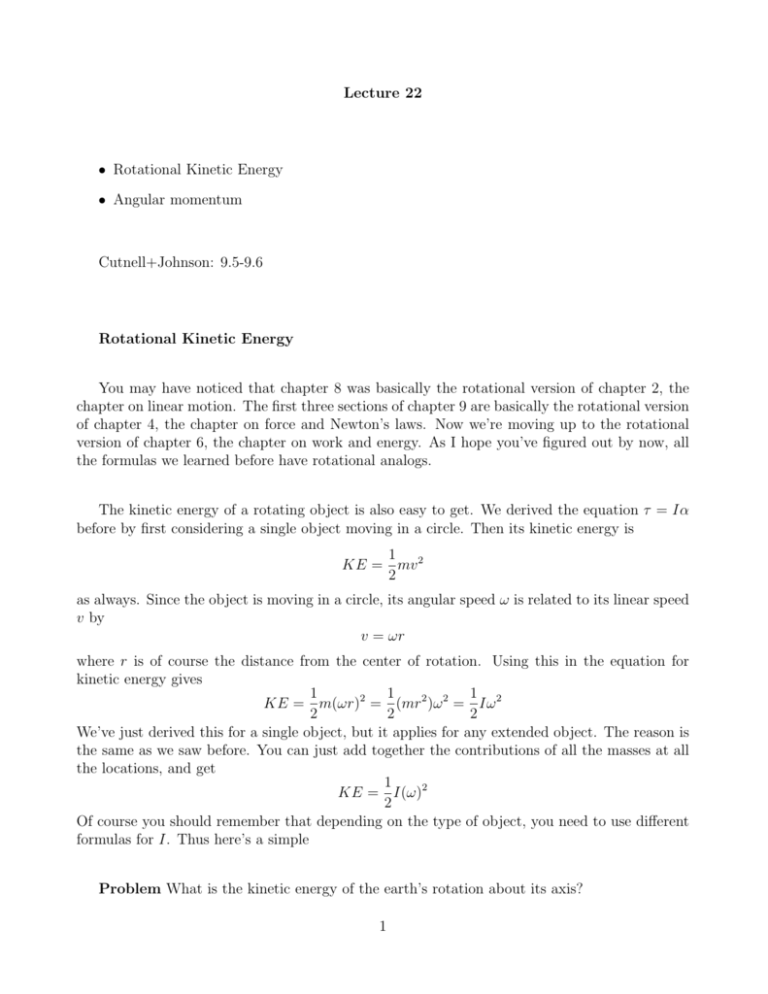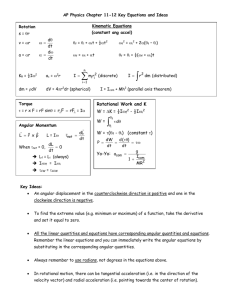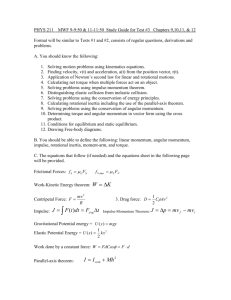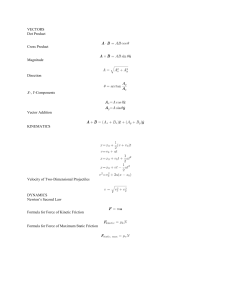Lecture 22 • Rotational Kinetic Energy • Angular momentum Cutnell
advertisement

Lecture 22 • Rotational Kinetic Energy • Angular momentum Cutnell+Johnson: 9.5-9.6 Rotational Kinetic Energy You may have noticed that chapter 8 was basically the rotational version of chapter 2, the chapter on linear motion. The first three sections of chapter 9 are basically the rotational version of chapter 4, the chapter on force and Newton’s laws. Now we’re moving up to the rotational version of chapter 6, the chapter on work and energy. As I hope you’ve figured out by now, all the formulas we learned before have rotational analogs. The kinetic energy of a rotating object is also easy to get. We derived the equation τ = Iα before by first considering a single object moving in a circle. Then its kinetic energy is 1 KE = mv 2 2 as always. Since the object is moving in a circle, its angular speed ω is related to its linear speed v by v = ωr where r is of course the distance from the center of rotation. Using this in the equation for kinetic energy gives 1 1 1 KE = m(ωr)2 = (mr2 )ω 2 = Iω 2 2 2 2 We’ve just derived this for a single object, but it applies for any extended object. The reason is the same as we saw before. You can just add together the contributions of all the masses at all the locations, and get 1 KE = I(ω)2 2 Of course you should remember that depending on the type of object, you need to use different formulas for I. Thus here’s a simple Problem What is the kinetic energy of the earth’s rotation about its axis? 1 Answer The moment of inertia of a sphere of uniform density rotating around its axis is 2 2 I = M R2 = (6.0 × 1024 kg)(6.4 × 106 m)2 = 9.8 × 1037 kg · m2 5 5 The angular speed of the earth is 2π radians/day, which is 2π/(3600×24) = 7.3×10−5 radians/s. The kinetic energy of rotation therefore is 1 1 KE = Iω 2 = (9.8 × 1037 kg · m2 )(7.3 × 10−5 rads/s)2 = 2.6 × 1029 J 2 2 Problem A bicycle wheel has a radius of .330 m and a rim of mass 1.20 kg. The wheel has 50 spokes, each with a mass of 10.0 g. The wheel is on a bike moving at 10.0m/s. What is its kinetic energy? Answer First, we need to find the moments of inertia. The center of rotation is the axle. All the mass of the rim is concentrated at the radius .33 m. Thus the moment of inertia of the rim is Irim = M R2 = (1.20 kg)(.330m)2 = .131 kg · m2 On the other hand, the spokes extend outward from the axle. Each spoke is like a door, so for each spoke we use the formula 1 1 Ispoke = M R2 = (.010 kg)(.330 m)2 = 3.6 × 10−4 kg · m2 3 3 The total moment of inertia of the wheel is therefore I = Irim + 50Ispoke = .149 kg m2 Now we need to find the energy. First, let’s find the rotational energy. We need the angular speed. A few lectures ago we showed how for rolling motion, v = ωr. Thus ω= 10.0m/s = 30.3 rad/s .330s and the rotational kinetic energy is 1 1 KErot = Iω 2 = (.149kg · m2 )(30.3 rad/s)2 = 68.4J 2 2 This, however, is not the total kinetic energy. The reason is that the bike and hence the wheel are moving as well. The total mass of the wheel is 1.20 kg + 50(.010 kg) = 1.70 kg, so the usual kinetic energy is 1 1 KE = mv 2 = (1.70 kg)(10.0m/s)2 = 85.0J 2 2 and the total is KE = 68.4J + 85.0J = 153.4J 2 We can use this kinetic energy combined with gravitational potential energy just like we did before. In the absence of forces other than gravity, we can still use ∆KE + ∆P E = 0 The only thing new this time is that we must remember to include the rotational part of the kinetic energy as well as the usual mv 2 /2. Problem An a ball rolls down a slope without slipping. It starts at rest at a height h = .40m. Assume no energy is lost to friction as it rolls. What speed does it have at the bottom? Answer The initial potential energy is P Ei = mgh while the initial kinetic energy is zero. The final potential energy is zero, while the final kinetic energy is 1 1 KEf = mv 2 + Iω 2 2 2 For an object rolling without slipping, v = ωr, so the final kinetic energy is 1 I KEf = v 2 (m + 2 ) 2 r At the bottom of the slope, the potential energy is zero. Thus the final kinetic energy is the same as the initial potential energy: KEf = P Ei 1 2 I v (m + 2 ) = mgh 2 r Solving for v gives v= s 2gh 1 + I/(mr2 ) This equation is true for any object rolling down a slope, whatever I is. Note that it is independent of the mass and the radius, because I ∝ mr2 . For a rolling ball, I = 2mr2 /5, so with h = .4 m, r 10gh = 2.4 m/s v= 7 Angular Momentum I mentioned briefly last time that the angular momentum of a rotating object is L = Iω 3 Let’s see where this comes from. Remember that torque is τ = Iα. Let’s relate the torque to the angular momentum, using the fact that the definition of angular acceleration is α= ∆ω ∆t This means that ∆L ∆ω = ∆t ∆t In the last step I used the fact that the inertia isn’t changing, so ∆L = ∆(Iω) = I∆ω. So this tell us that a torque causes the angular momentum to change. This is just like the linear case. There we have ∆v ∆p F = ma = m = ∆t ∆t A force changes the momentum, a torque changes the angular momentum. τ = Iα = I From these formulas it follows that if there are no external forces, ∆p = 0: the momentum does not change. Likewise, if there are no external torques, the angular momentum does not change. The demonstrations on the spinning stool relied on this fact. There are no external torques on the stool (neglecting the friction in the stool itself). Thus the total angular momentum is conserved. We already saw that if you decrease the moment of inertia by pulling weights in, the angular speed must increase. If I goes down, ω must go up to keep L = Iω constant. Here’s a slightly more complicated problem. One other thing about angular momentum: it is a vector. The direction of the vector is along the axis of rotation. So this is in fact how airplanes used to tell which direction they were going. The would have a wheel spinning around, on a mount which can move essentially friction free. Thus when the plane turns, the wheel keeps spinning with the same axis of rotation. This is conservation of angular momentum. Not only does the magnitude stay the same (in the absence of external torques), but the the axis of rotation must stay the same as well. This is what allowed the plane to keep track of which direction it’s moving. To tell all possible directions, the plane actually needs 3 gyroscopes. Nowadays, there’s this satellite system (the global positioning system) which you can even get in your cars, so the gyroscopes are obsolete. 4







